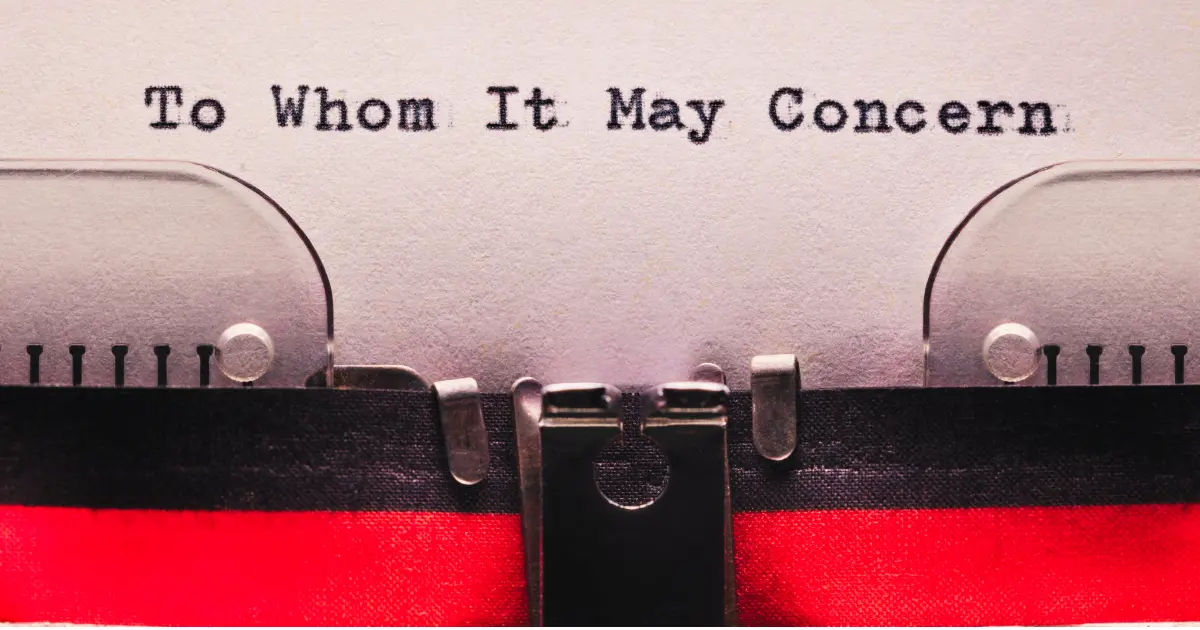The classic “To Whom It May Concern” is a salutation that’s stood for years in formal letters. Although it may seem simple, writing a well-crafted letter using this opener requires accuracy and professionalism. If you do it right, writing a reference, confirmation of employment, or legally binding reference will create a lasting impression. This blog post will show how to compose anyone it concerns and avoid the most frequent mistakes.
TO WHOMSOEVER IT MAY CONCERN Letter
A To Whomsoever It May Concern letter is used whenever it is required to be specific to the addressee. This salutation suits various scenarios, from employment applications to legal references. This is important because it effortlessly adapts to situations where you do not possess specific information about the people likely to read your message. It maintains professionalism and ensures that the right audience reads the message regardless of individualization.
Why It Matters in Professional Communication
The type of letter functions as a solid bridge. Imagine needing a recommendation from a professional and not being sure who from the company is about to review the letter—making a formal document to be used for legal reasons that could have different recipients.
When to Use
What is the best time to utilize formal salutations like this? These are some of the more typical scenarios that lend it a perfect answer.
1. Job Applications
When applying for jobs via an online platform that does not provide information on the person hiring you, “To Whom It May Concern’ can save the day. It’s beneficial in general recommendations or letters of introduction.
2. Proof of Employment
Employers frequently use this format to check an employee’s position specifics, including pay and tenure, without addressing specific employees within the organization. For example, this is necessary to obtain a home mortgage or secure a rental in real life. Most financial institutions will accept job verifications with the words “To Whom It May Concern.”
3. Academic and Legal References
This is the standard format for admissions to academic institutions, referrals, or other legal issues in which the person receiving may differ. Consider court cases or university applications for students who do not know the specific admissions representative.
4. Vendor or Business Relationships
Letters to business clients, such as those establishing partnership agreements or asking questions to new suppliers, can utilize this structure effectively when the individual who made the decision is not well-known.
Understanding the Structure of the Letter
Once you’ve decided what to do with the letter, how can you structure it for the most significant effect? An effective letter is similar to an elegant presentation. It has a natural arrangement
1. Salutation
Use bold and underlined “To Whom It May Concern”; however, keep the rest of the letter in line with the layout.
2. Opening Paragraph
The purpose of your letter should be concise and clear in the first paragraph and include concerning stakeholders’ information with time.
3. Main Body
Provide all relevant information to support the letter. Concentrate on details like names, titles, achievements, timelines, etc. Your points should be organized systematically, using concise paragraphs to ensure ease of reading.
4. Closing Statement
Finish with a formal sound. Be sure to reiterate your goals briefly and then formally announce your conclusion with a formal sign-off, like “Sincerely” or “Respectfully.”
Step-by-Step Guide to Writing the Letter
Here’s an easy method of creating your next “To whom it may concern the note.
Step 1: Identify the Purpose
Think about what this letter is sending. Define your primary message regardless of whether you confirm your employment and a reference or reveal important information.
Step 2: Gather Relevant Information
Be sure to include all the information—names and dates, achievements, job titles, and any other information necessary for achieving the goal. The accuracy of your information is crucial!
Step 3: Use Professional Language
Be respectful. Maintain a respectful tone throughout. Beware of slang and conversational words regardless of whether the topic appears informal.
Step 4: Proofread and Edit
Make sure that errors in grammar, spelling, or formatting mistakes do not contaminate the letter you send. An elegant letter immediately creates a positive impression.
Common Mistakes
Experience writers are also not exempted from these mistakes. Beware of these mistakes when you write your letter.

Mistake #1: Excluding Key Details
The inability to remember important details, like dates or the roles of your letter, is unreadable or unclear.
Mistake #2: Using a Generic Approach
The letter must be relevant and free of generic, repetitive phrases. Write in a thought-provoking, personal tone that stands out.
Mistake #3: Poor Formatting
Text crammed together and lacking structure or alignment can result in a non-appealing layout. Make sure to use a neat, professional design.
Examples
- Appointment / Termination Letter: An easy format to effectively confirm someone’s name, job title, and duration.
- Character Reference Letter: The article highlights an individual’s strengths and abilities professionally.
- Academic Recommendation Letter: The applicant’s ability to demonstrate academic accomplishments concisely.
FAQs
Does it seem obsolete to use “To Whom It May Concern”?
Not at all! This is still an accepted salutation for professional communications, mainly when particular names aren’t available.
Do I have to use informal language in a letter?
No. A formal tone of voice is vital for maintaining professionalism and trustworthiness.
Should the letter always be very detailed?
Be sure to provide sufficient information to meet the letter’s goal concisely.
Conclusion: Perfecting Your Letter
The art of crafting a flawless TO WHOMSOEVER IT MAY CONCERN letter requires attention to all the details, such as language structure, tone, and structure. Start writing your formal document in a compelling style now!


